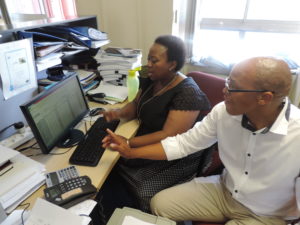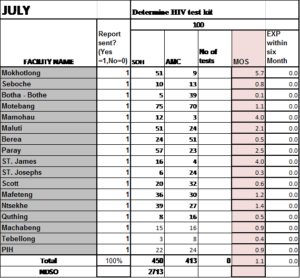By Almakio Phiri, SIAPS Lesotho Country Project Director; Katelyn Payne, Project Associate; Andreas Fusi, SIAPS Laboratory Logistics Advisor; and Pheello Pompong, SIAPS M&E and Communications Advisor
Expanding Laboratory Testing Services
Lesotho has the second-highest HIV prevalence rate in the world, with 22.9% of the population living with the disease. The severity of this public health crisis is exacerbated by the a significant gap between the number of people on antiretroviral (ARV) treatment and the number of people with HIV/AIDS in the country—only 28% of the 360,000 people living with HIV in Lesotho were receiving antiretroviral therapy in 2013, according to the World Bank.
The good news is that HIV/AIDS health care services are expanding in Lesotho, and laboratory testing services, including HIV rapid test kits (RTKs), are now provided at health centers. The availability of laboratory commodities at health centers is therefore essential to identifying patients’ HIV status and referring them for treatment. With the expansion of these services—previously only available in hospital laboratories—to health centers, testing for HIV is becoming more accessible and the number of people being tested for HIV is noticeably increasing.

From Lesotho’s capital city of Maseru, Laboratory Logistics Coordinator Retselisitsoe Ramanyatsane closely monitors the distribution and use of HIV RTKs and other laboratory commodities from her desk at the Ministry of Health (MOH)’s Directorate of Laboratory Services. She knows that to ensure the availability of commodities at health centers stock supplies must be tracked and redistributed to prevent stock-outs and overstocks.
In the past, stock levels were not routinely reported to the Central Laboratory Store (CLS). Ms. Ramanyatsane noticed that facilities were only reporting their stock status when they needed a stock replenishment. Commodities could not be redistributed among facilities to avoid stock-outs and product expiry. With data being reported inconsistently to the CLS, the National Drug Service Organization (NDSO) was unable to resupply health centers with the commodities they needed. Poor reporting rates by hospital laboratories and the absence of continuous feedback from logistics managers left the national stock data incomplete and inaccurate. Service disruptions due to stock outs were common.
Now, Ms. Ramanyatsane plays a crucial role in the communication of logistics information between the procuring agency and distributors of laboratory supplies in Lesotho. She monitors the reporting of stock status by hospital laboratories to the CLS and NDSO. The CLS shares national stock data with the NDSO that supplies essential commodities, including HIV RTKs, to hospital laboratories. Hospital laboratories distribute all laboratory commodities to the health centers within their district. Instead of traveling long distances to be tested at hospital laboratories, patients can now easily access the same services at health centers.
A Partnership for Improved Reporting and Decision Making
At the MOH, the Directorate of Laboratory Services’ Logistics Office uses monthly Logistics Management and Information System (LMIS) reports to manage the distribution of laboratory commodities to 17 hospital laboratories throughout Lesotho. Ms. Ramanyatsane urgently needed an intervention to encourage consistent reporting and accurate quantification of supplies by facilities. In partnership with the Government of Lesotho, the USAID-funded Systems for Improved Access to Pharmaceuticals and Services (SIAPS) Program is supporting improvements in supply chain management through forecasting needs, supply planning, and stock level monitoring to help Lesotho reach targets set by the National HIV and AIDS Strategic Plan (NSP) 2011/12–2015/16.
In April 2014, SIAPS introduced a Laboratory Commodities Monthly Stock Status Report to improve stock status monitoring, avoid stock-outs, and serve as a national database of laboratory commodities stock levels in Lesotho. In designing the Laboratory Commodities Monthly Stock Status Report, individual records were developed for each of the 22 laboratory commodities that are distributed to health centers in Lesotho. The report is used to measure the stock status of HIV RTKs and blood specimen collection and processing tools, such as tubes, reagents, and cleaners.
SIAPS Laboratory Logistics Advisor Andreas Fusi trained Ms. Ramanyatsane on how to add data to the report and use it for decision making. By consolidating monthly LMIS reports, the report allows the laboratory logistics coordinator to track the stock on hand, the average monthly consumption of supplies, the number of tests performed, and the number of products to expire within six months at each hospital laboratory in Lesotho. Aggregating data at the national level allows information on stock status at the facility level to inform decisions on nationwide procurement and stock distribution. Now that Ms. Ramanyatsane is able to view all critical logistics data from hospital laboratories in one central location, she can report to the NDSO when a new procurement is necessary and provide feedback to hospital laboratories on their reporting rates.
The Laboratory Commodities Monthly Stock Status Report encourages the MOH to manage stock differently by identifying gaps in reporting. Even when facilities fail to submit reports, Ms. Ramanyatsane is able to identify those facilities immediately and make prompt follow-ups accordingly. She has noticed that hospital laboratories began reporting their stock levels on a regular basis after the introduction of the comprehensive report.

Moving Stock between Health Centers
“This tool has not only helped me to compile and analyze the stock level by facility and nationally, but it has also helped me to facilitate the redistribution of commodities between facilities,” Ms. Ramanyatsane said.
Knowing the current stock levels of laboratory commodities, the MOH and NDSO can now accurately move stock between health centers to avoid stock-outs. Products are no longer sitting on shelves, approaching their expiration date. This immediate redistribution of commodities ensures that when patients travel to a health center for an HIV test they will not be turned away.
Facility reporting rates have dramatically increased from 61% in the last quarter of 2012 to 94% in the fourth quarter of 2014. Staff at hospital laboratories now recognize that when they accurately report on stock supply unused supplies can be redistributed among facilities to avoid wastage and stock-outs. Ms. Ramanyatsane and her team at the MOH are now closer to identifying new HIV/AIDS cases through patient testing at more than 150 government-run and Christian Health Association of Lesotho-run health centers in Lesotho.

